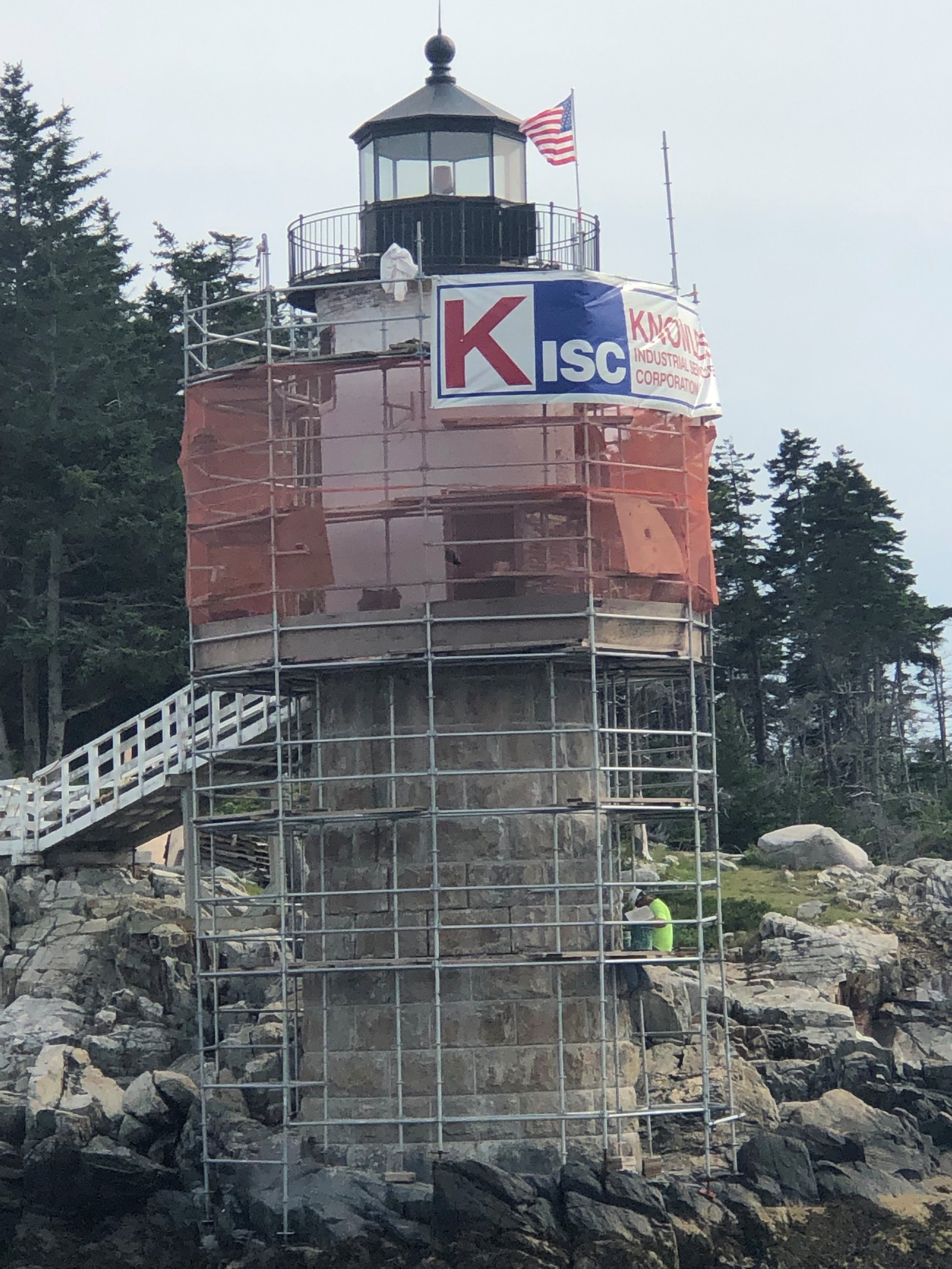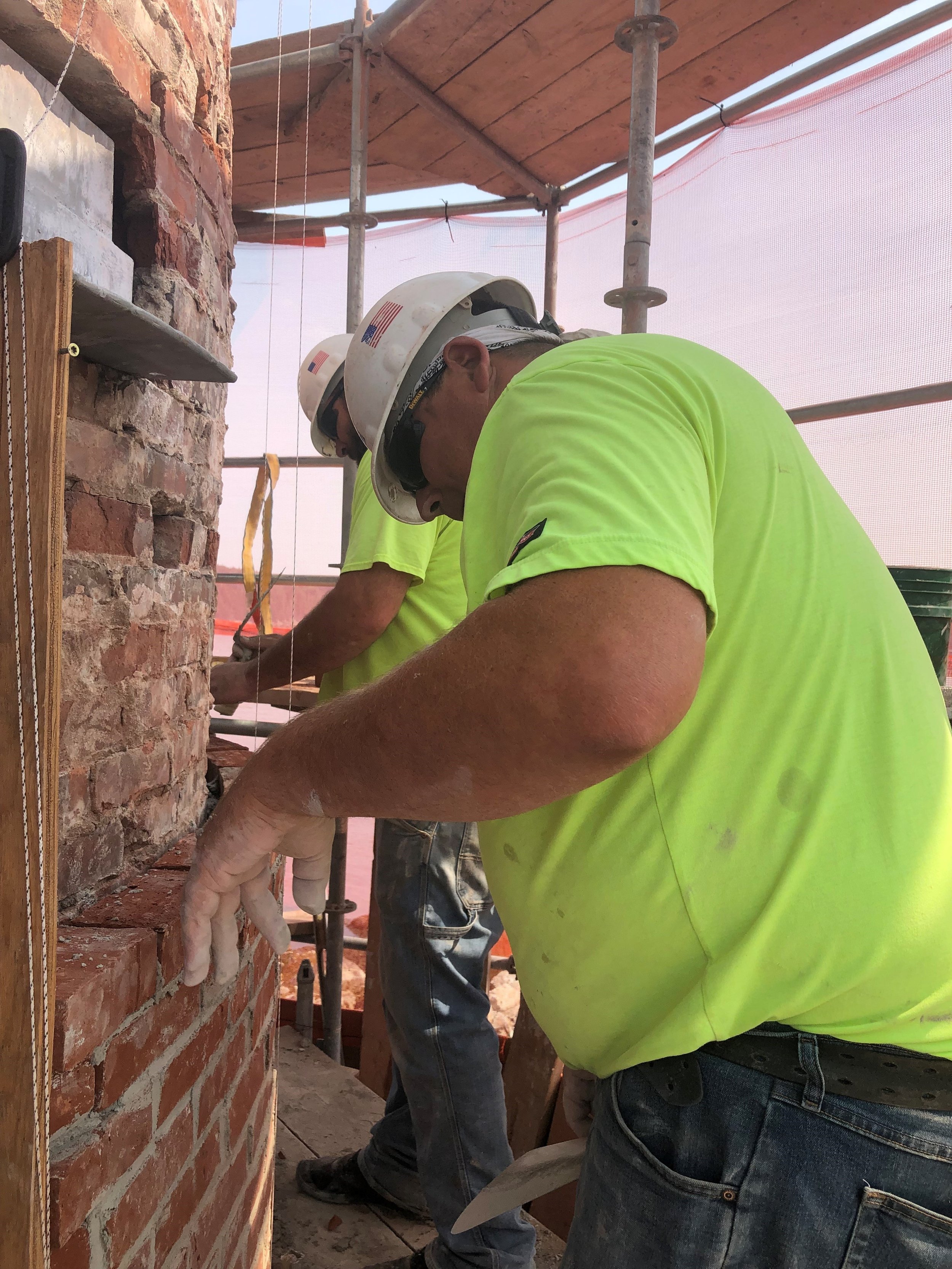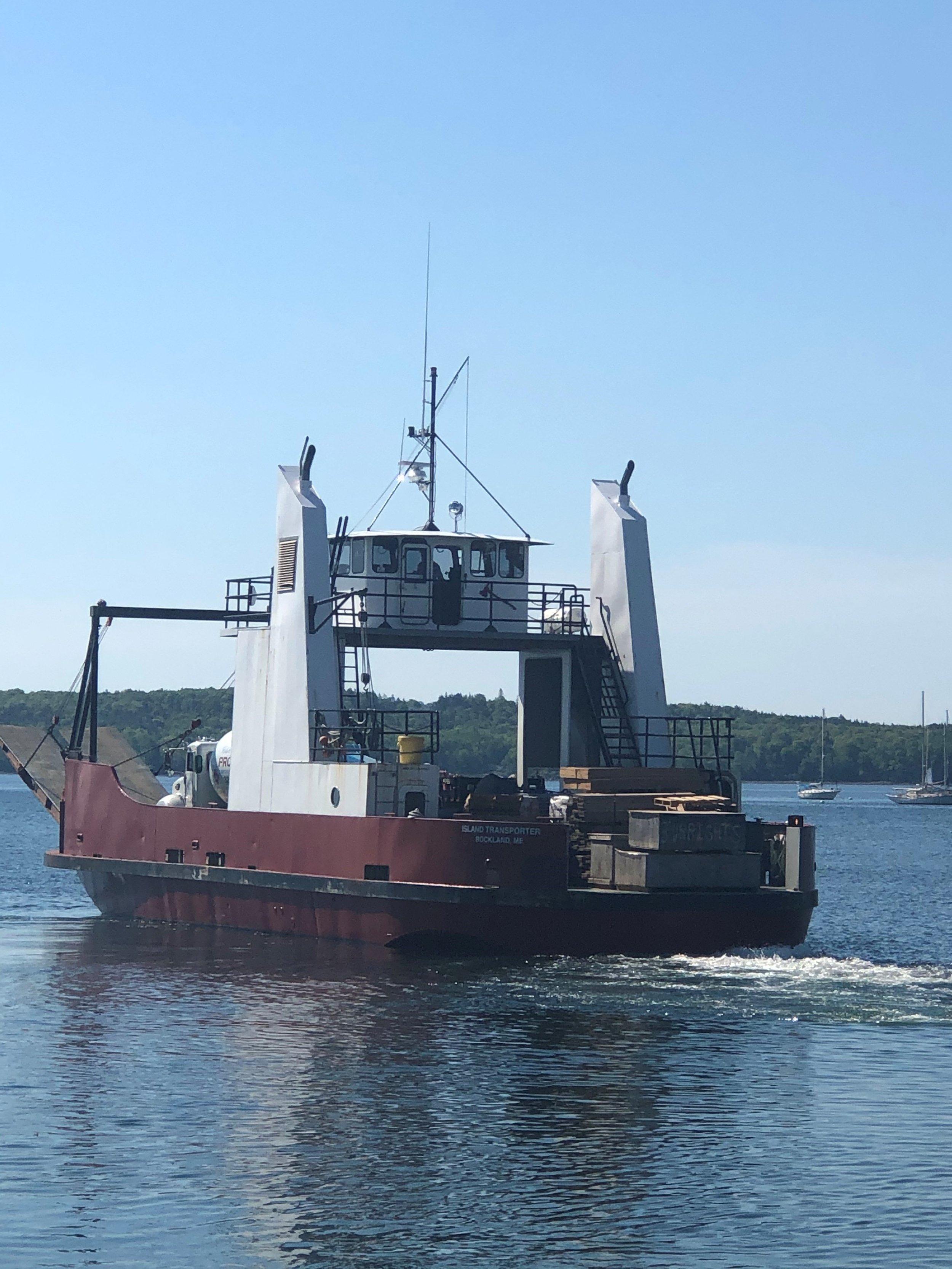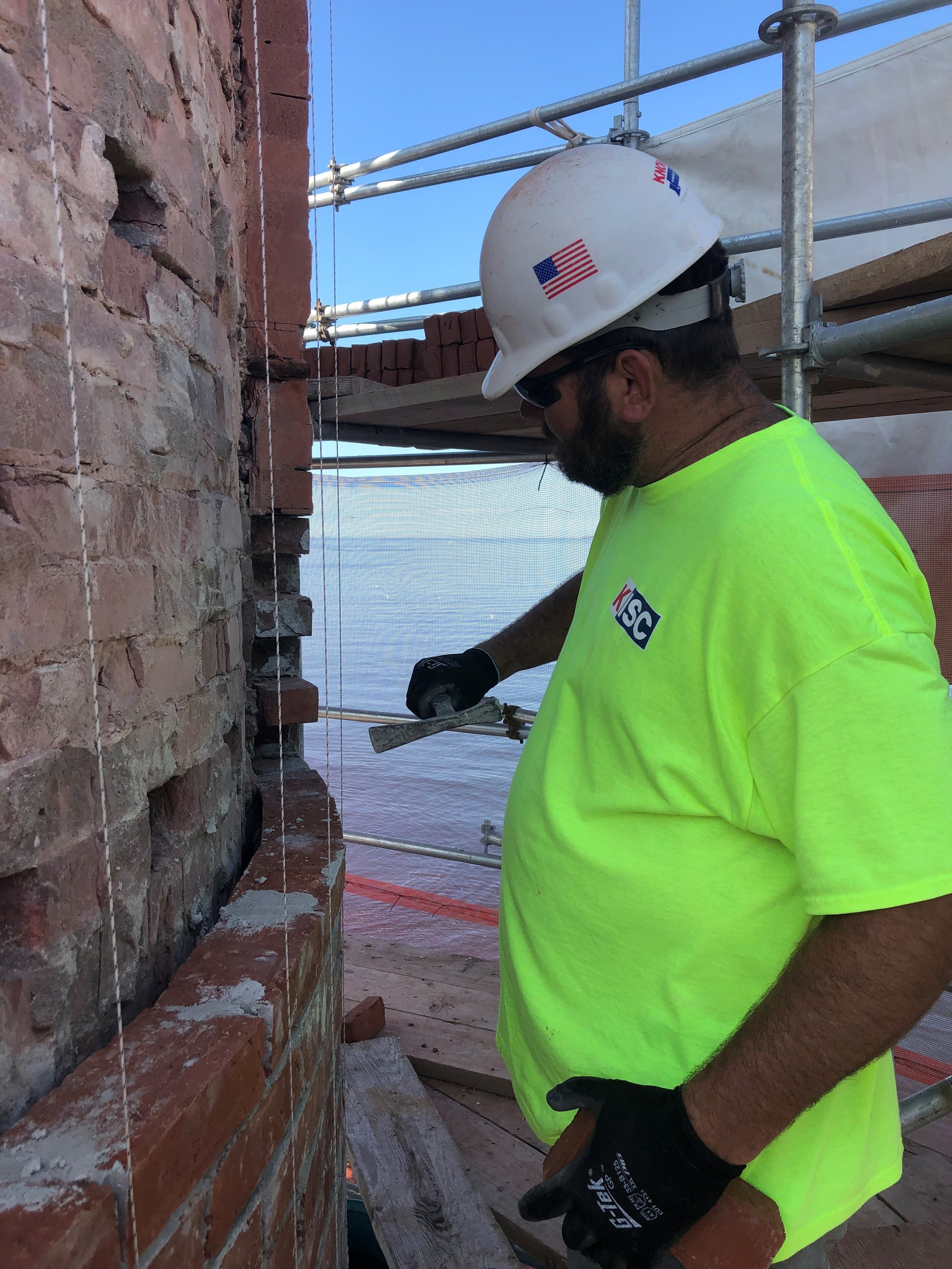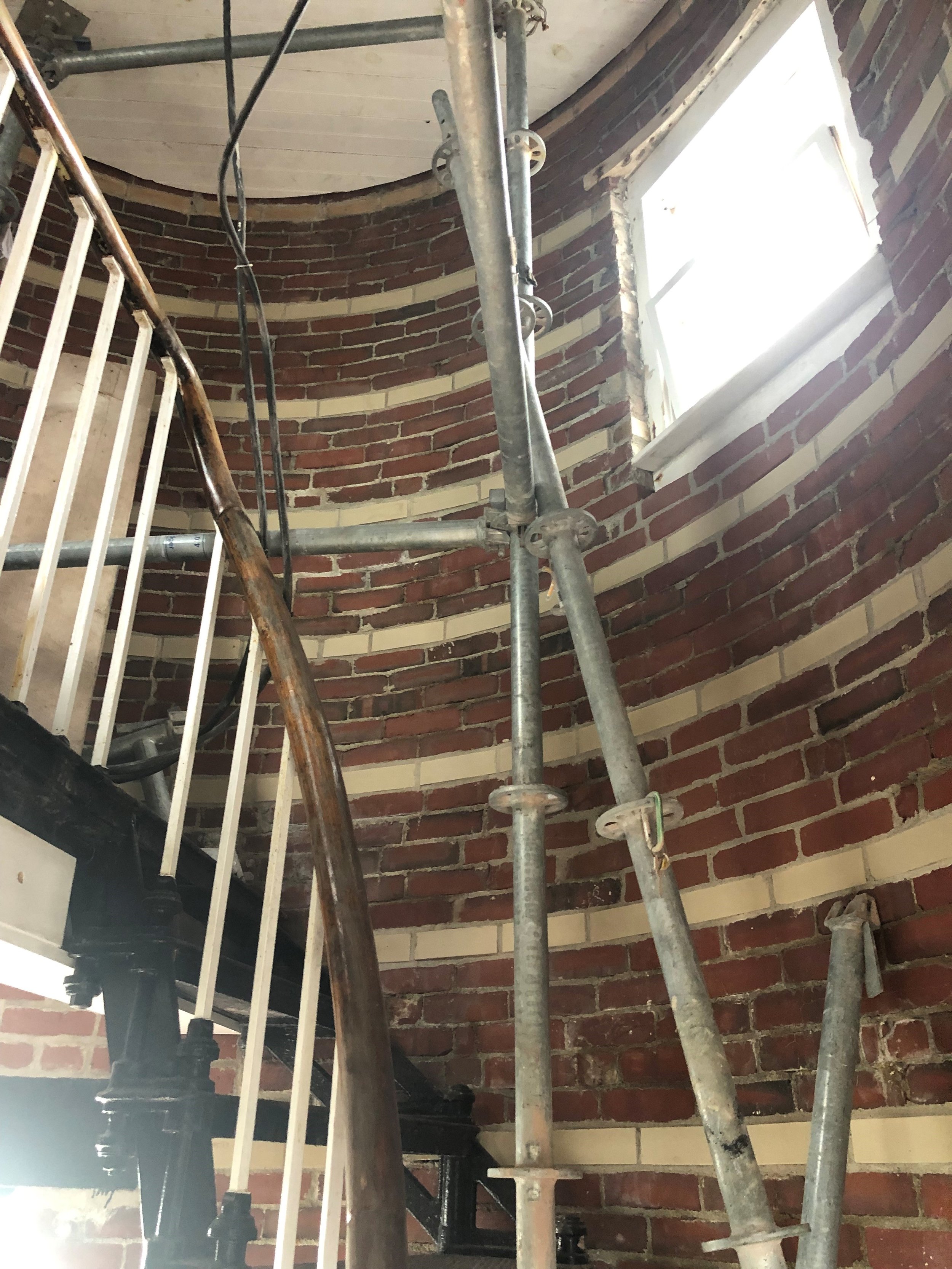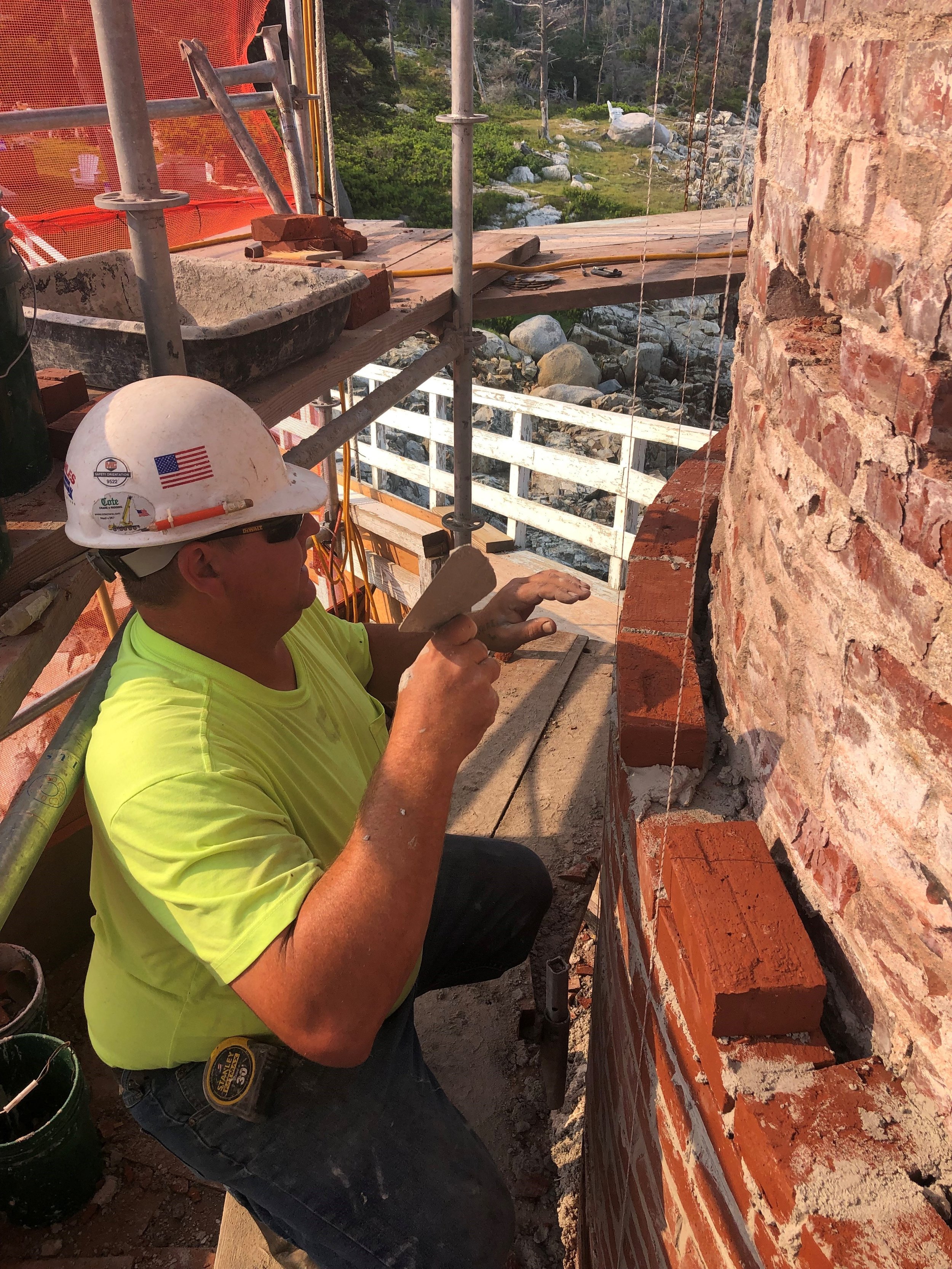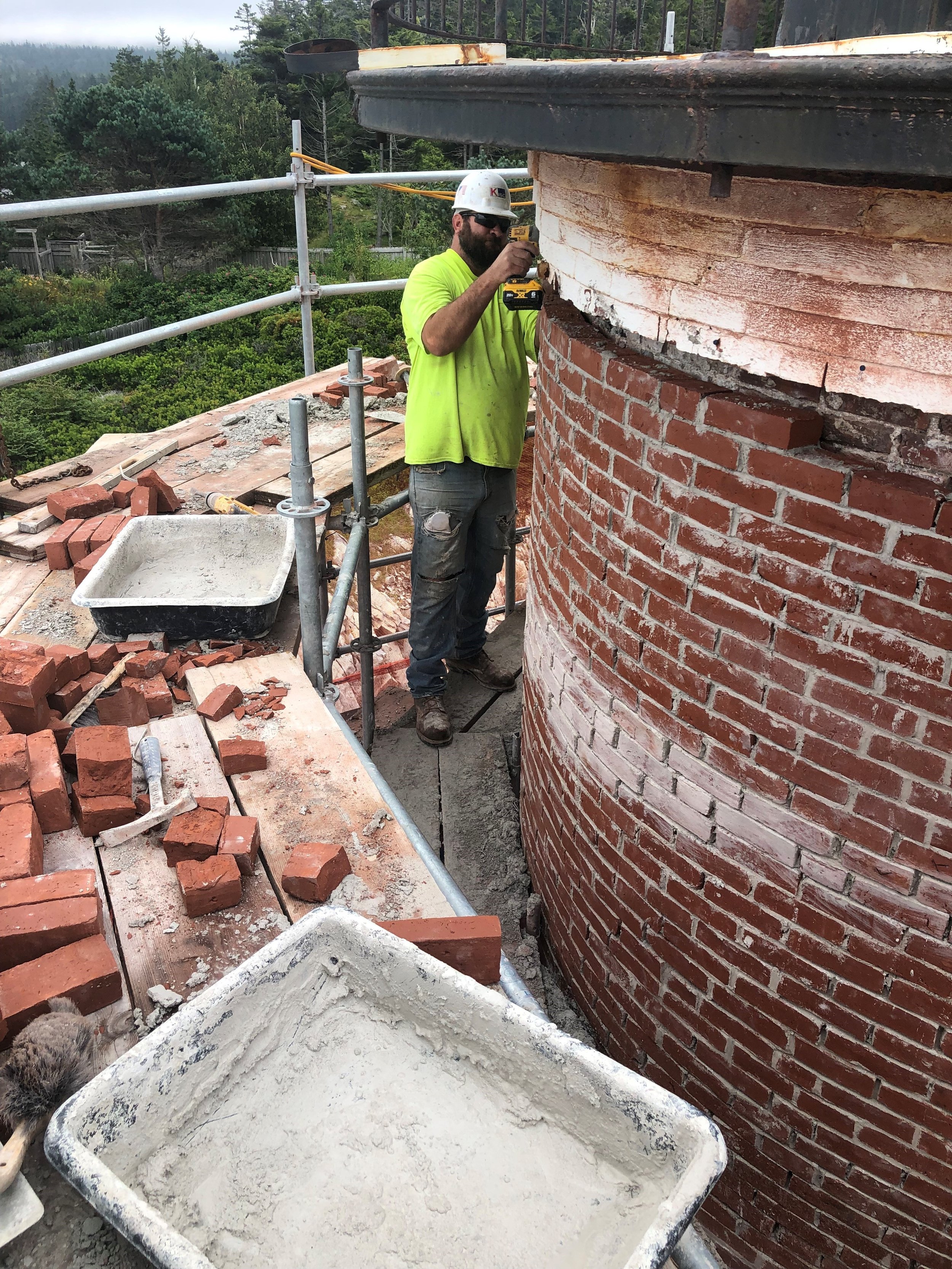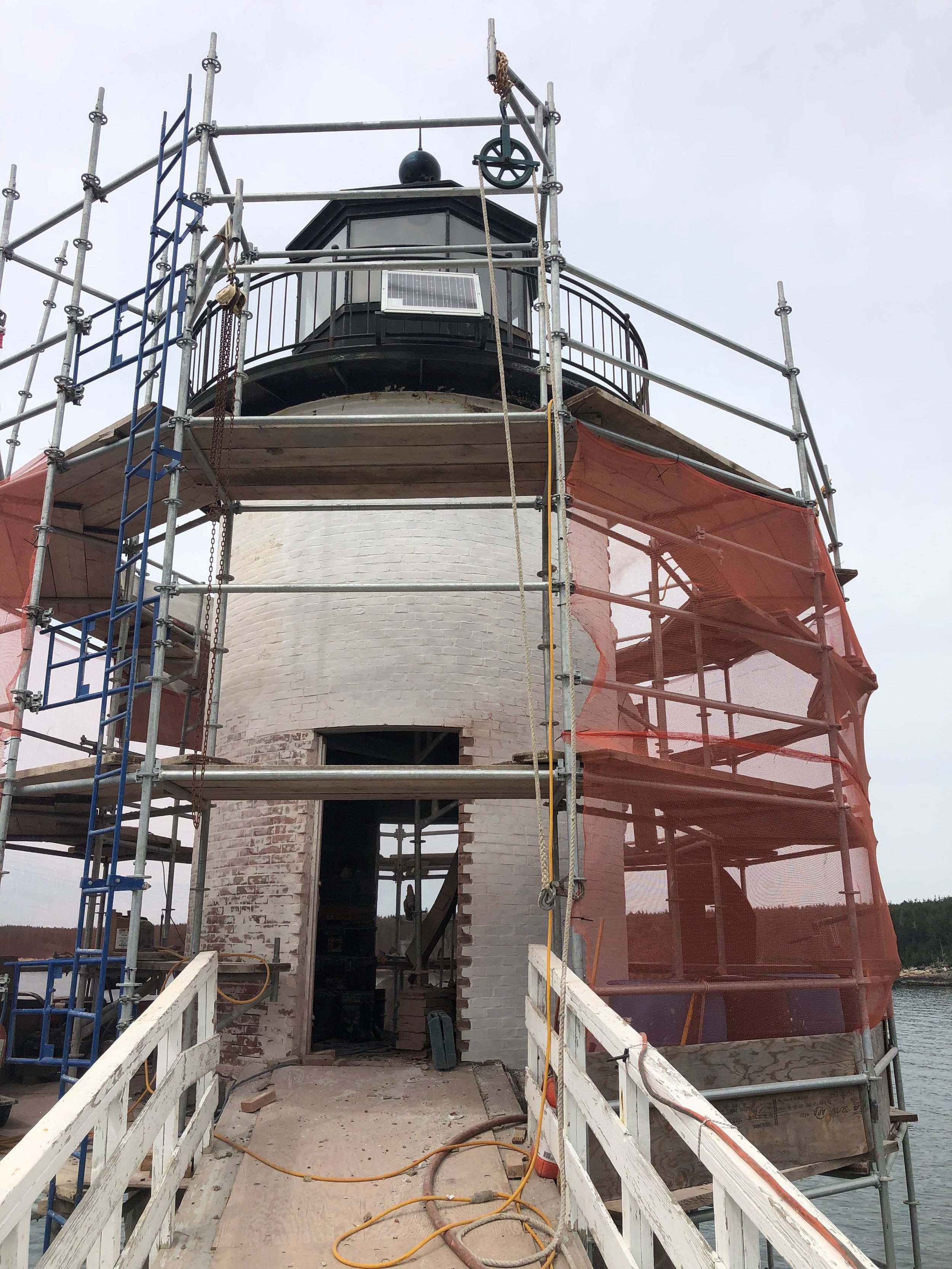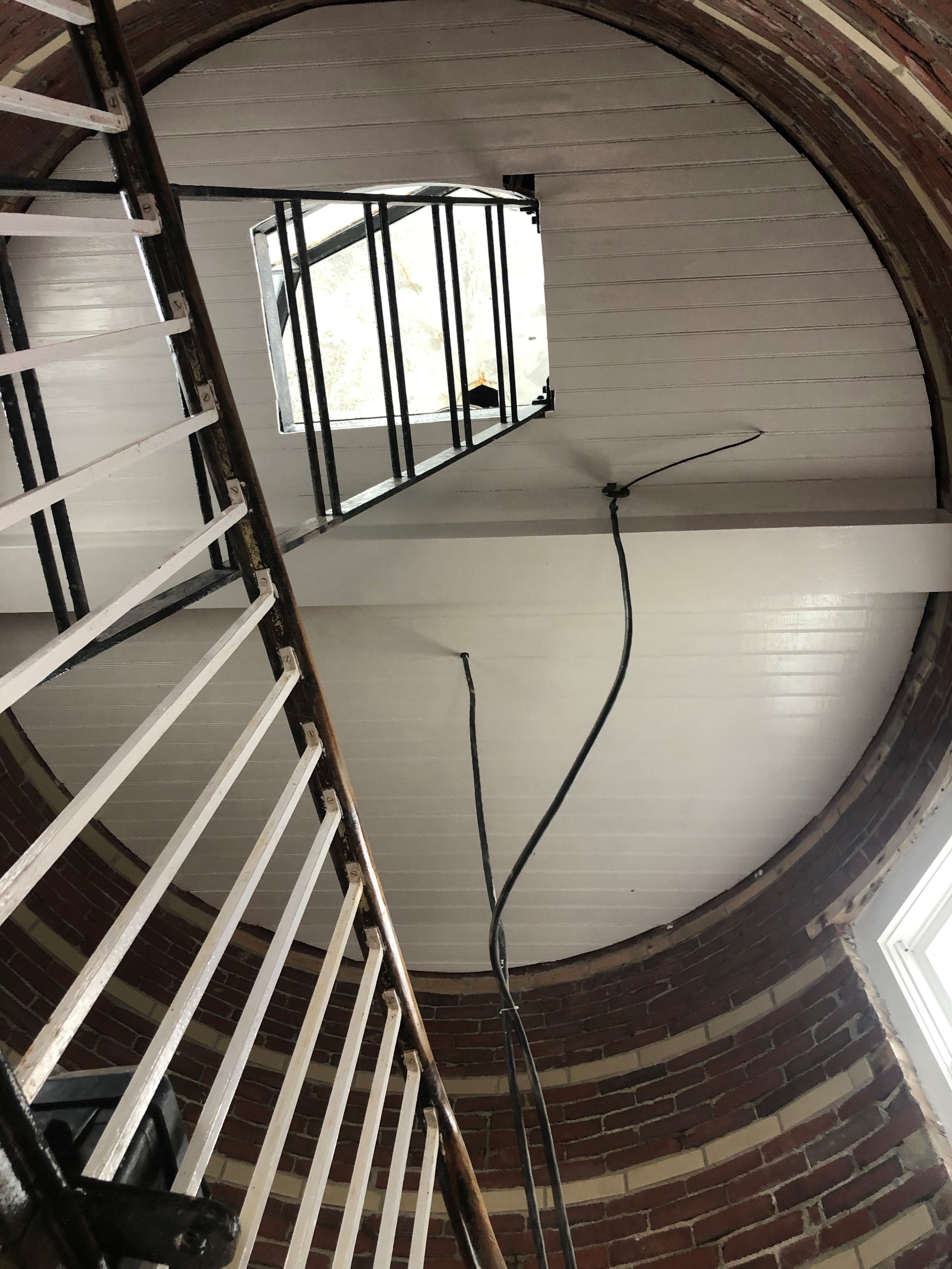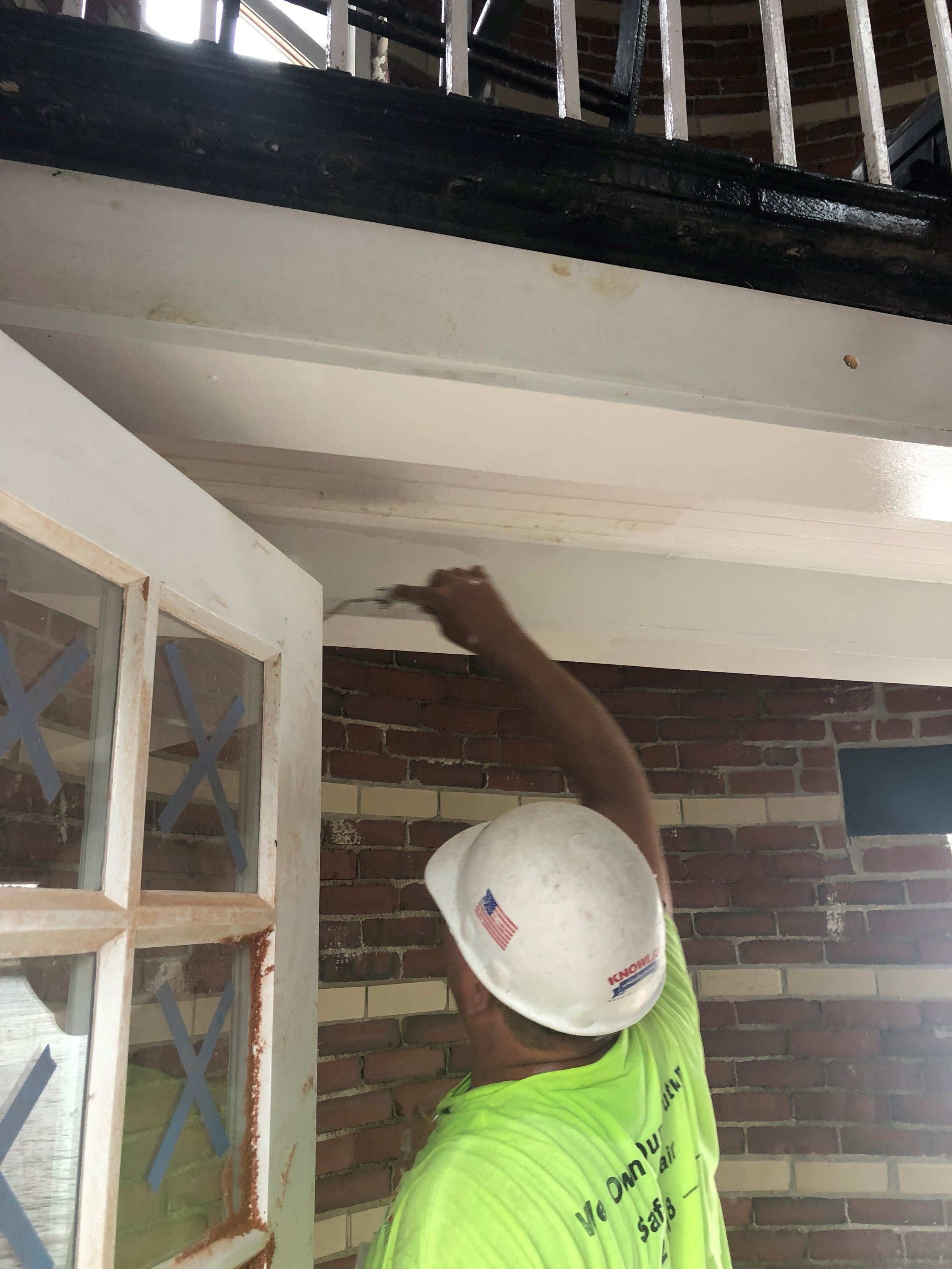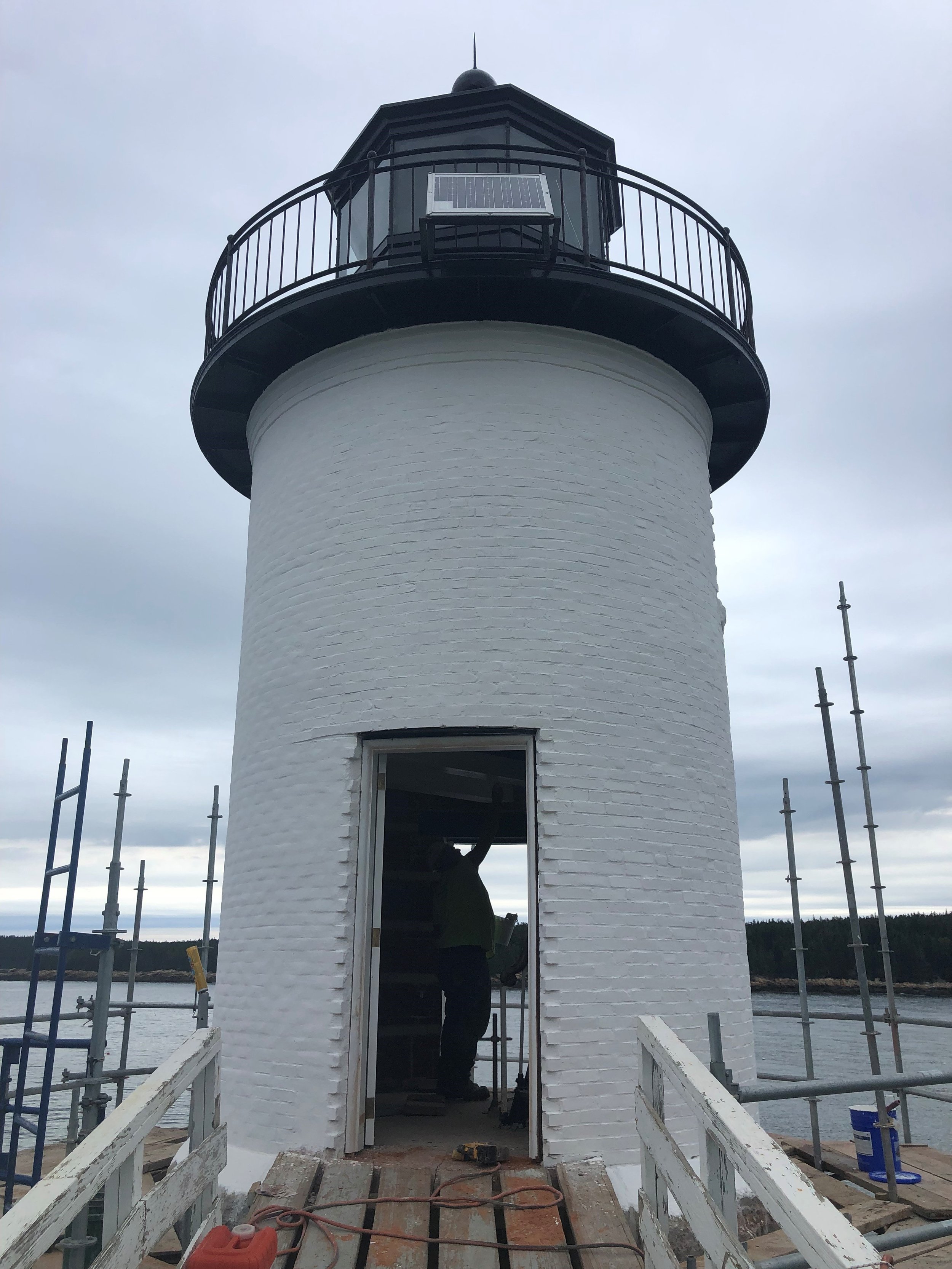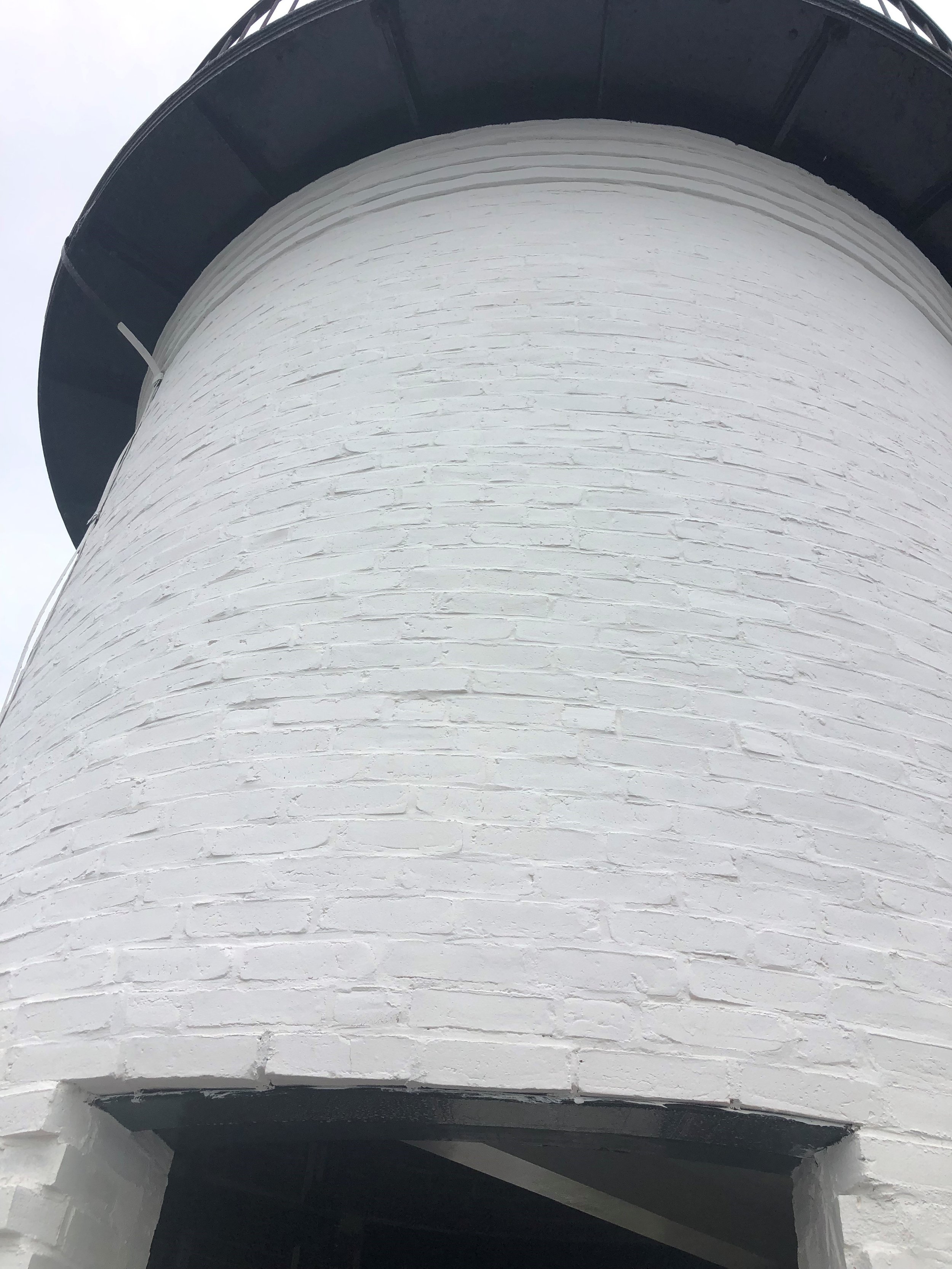Project Perspective
Isle Au Haut Lighthouse
Project Summary
Built in 1907, the Robinson Point Fog Station, now called The Isle au Haut Lighthouse, was the last lighthouse of the 60 that were built in Maine. The lighthouse’s purpose was specifically to guide the New England ground fishing fleet into safe harbor during storms.
WINNER of BUILD MAINE Award
Unique Projects
The purpose of the restoration was to repair the failing brick façade, completely repoint the large granite stone blocks serving as the base, bring the exterior of the lighthouse back to its original historic construction, restoration and upgrades to the interior, including new structural support beams for the interior deck level and a support beam for the lantern top, repairs and rebuilding of the inner wythe of brick. Part of the north side of the lighthouse had seen a large section of brick replacement completed around 10 years ago, however the work was not completed to proper historic construction methods and was already failing due to a lack of replacements of the brick header courses and the lack of use of any brick ties. Once we started the demo work, it was evident that this recent repair area was completely loose and would have soon fallen off the side of the lighthouse after a couple more cycles of winter and freeze thaw. We ended up completely removing and rebuilding the entire outer wythe and some of the middle wythe of the north side of the lighthouse. Historically accurate natural cement and mineral stain coating brought the exterior to a like new condition once complete.
The lighthouse tower itself was turned over to the town from the federal government in 1998 and is maintained by the town’s Lighthouse Committee and still serves today as a registered aid to navigation for the local fisherman and all watercraft passing through the greater Stonington area by boat.
Following all the repairs, the Historic Isle Au Haut Lighthouse is ready for a continued long lifetime of service, protecting the marine community.
Owner – Town of Isle Au Haut
Owners Representative – Susan Chamberlain – President, Friends of Isle Au Haut Lighthouse
Engineer of Record– Carmen Bombeke, Gartley & Dorsky Engineering& Surveying
Maine Historic Preservation Rep – Mike Johnson
Project Manager – Tim Rich, Knowles Industrial Services
Project Foreman – Logan Hurlbutt & Chris Carr, Knowles Industrial Services
Project Duration – June 2021 – September 2021
Total Project Value - $287,300.00
A) Contribution to the Community
The most important contribution the lighthouse serves is to the marine community as an aid to navigation. The lighthouse is also a major tourist attraction along with the Acadia National Park Lands on the island. By restoring the lighthouse to its original construction and beauty it provides safety for the resident fisherman and a continued stream of tourist income to the island community and its 3 local storefronts.
Living on the island during the week days, the crew and most of the 60 full time residents of the island community became friends. There were several instances where we were able to help out people in the community in the evenings with some of the equipment we had on the island, specifically the lull. In one instance, the crew help to move a precast septic tank that had been sitting in the wrong location for years but had no way to relocate it. The crew also used the lull to lift and block up an old Caterpillar grader that had been stuck on the side of the road for years, allowing the owner to finally get a trailer underneath of it and haul it back to his yard. In return, meals and the occasional after-hours beverages were shared around some of the local’s kitchen tables with our crew onsite, telling stories and playing cards! They even asked the crew to be part of the July 4th parade down “main street” in the company truck.
In 2019, two young women took on a fundraising effort to help the Lighthouse Funding Raising committee in their efforts to raise funding for the restoration project. They spent 18 days during the summer of 2019 swimming 18 miles around the island to raise $18,000 for the project. See WCSH 6 video. Here’s one way to raise money for a Maine lighthouse—swim all the way around it - Bing video
B) Innovation in Construction Techniques or Materials
The innovation on this project was to go way back in time to old school methods. Early 1900s masonry construction, in a lot of instances, used Natural Cement for the mortar unlike todays stronger Type I/II type cements. We were able to source this material from a company in Connecticut and even able to match the original color of the mortar.
On the exterior we were able to match the original Potassium Silicate mineral based breathable coating. These types of coatings were very popular 100 years ago and are still intermittently used today, on historical sites. These are only available from a few manufacturers compared to the more modern technology coatings used widely today and available everywhere.
Replacing the structural steel beams that supported the intermediate deck level and the lantern support deck required some innovative use of shoring, staging posts and 8”x 8” timbers in combination in order to support the entire interior of the structure that also held up the lantern top all while we removed the existing beams through holes we had to make in the side of the lighthouse at both levels.
C) Challenges of a Difficult Job
The biggest challenge with this project was obviously the location. The lighthouse is on an island several miles off the coast. We could not just run to the hardware store to get something we forgot or needed. Everything we needed to have onsite that couldn’t be carried by hand on the ferry boat needed to all be delivered to the site on the delivery barge trip from Rockland on day one of the project. There were no second chances without hiring the barge for a full day again, which took weeks to schedule in advance. We had a crew cab, Lull and 25 racks/pallets of staging, equipment, bricks and mortar on the barge to be used over the course of the summer out on the island. The initial setup, material procurement, lodging arrangements, booking of the barge, staging all the materials at the barge landing area ahead of time took as long as the project itself did to complete.
There was also no power or fresh water at the project site. We had to run a generator when power was needed. Another challenge was the fuel supply options available only the island, only gasoline. So, we bartered with the island “road commissioner” to borrow one of his fuel cells and get fuel delivered to the island by the barge when it made propane deliveries to the island to fill both our needs. Water needs we met by filling empty barrels at the well of the “fire station” and using a pool pump in the barrel for a delivery system once delivered out to the lighthouse.
D) Environmental Sensitivity
Project environmental considerations are always built into the pre-planning process at Knowles. All projects undergo analysis with the Owner to ensure all special individual or site-specific requirements will be met as well as prevailing local, state, and federal regulations for their potential impact on the environment.
At Knowles, a Project Environmental Plan is combined with a Project Safety Plan to provide for the over-arching Project Safety and Environmental Plan or “PSEP”
The PSEP process for the Isle Au Haut Lighthouse identified many environmental items for consideration with the main focus being on three potentially high-impact by-products of the work: dust, noise, building envelope coating chemicals as well as the trash that we normally just take for granted that we can through away. Most all the trash and debris needed to be shipped back off the island at the end of the project.
In order to contain and manage these pollutants, Knowles instituted many procedures via the PSEP where they would be emphasized daily through the daily PSEP review through increased awareness and monitoring.
Some of these procedures were:
1. Minimize or eliminate dust from grinding, cutting or chipping stone and mortar by closely following OSHA 1926.1153 and Table 1A to include power tools with HEPA vacuums. In cases where this was not practical, alternate engineering controls were implemented and all surfaces were pre-dampened and/or water used to suppress silica dust
2. All Minimize noise by defining times of day that chipping, grinding or hammering of brick and stones would be allowed. This allowed the adjacent vacation rental occupants to more closely plan their vacation days to be in a position to tolerate some external noise. Noise generating tasks were always started after 9 am to allow for the renters to sleep and get there day started.
3. Tarps and poly were constructed on the staging level at the base of the brick section of the lighthouse to collect any debris, drips or spills from the exterior work items which if not collected would have ended up directly in the ocean below.
E) Responsiveness to Client Needs/Customer Satisfaction/Partnering
Knowles worked with the owners and even agreed to a 2-year delay of the project to help the client. Agreeing to delay the project at first to allow for more time for fund raising. Then delaying again for the island community’s safety during COVID while holding pricing steady from our 2019 Contract amount. Despite all this, we were able to complete the project on time and actually completed the project at 10% under the original $310,000 contract cost.
Both the engineer and the State Preservation rep were eager to help and willing to come out to the remote island in a timing manner when the owner requested. A lot of upfront collaboration work between the Engineer, State Preservation and the owner and then adding Knowles made for a very unified and cooperative partnership. It turned out to be a win-win for all parties involved with a fantastic final product for all to be proud of having a hand in completing.
We did however, make an emergency trip to the island in the fall of 2020 at the request of the island and the engineer to complete the repointing of the base stones up as high as we could reach from the ledge prior to the winter in order to minimize any more freeze thaw damage from the upcoming winter.
Working with local resources, trading our onsite equipment use for fuel or delivering brick debris disposal for clean fill, helping unload food supplies to the local coop or getting water delivery to the site, everyone was willing to help in anyway they could to have this project come together.
F)_Safety
As with all Knowles operations and projects, worker, owner and public safety are paramount importance during all elements of any work.
The lighthouse is on a point of land on an island, typically accessible by a 45-minute ferry boat ride away that only runs on a set schedule during the day. Any emergency situation would require a special trip with the ferry boat, or as a backup plan, we had on call a private boat owner on the main land with a faster lobster style boat that could make pickups from the island if needed. We also developed relationships with a couple of the local fisherman who would be able to run someone in to Stonington if needed.
Another major safety challenge on the project included elevated risks associated with building and working from fixed scaffold at heights approximately 50’ above the water. Working with and around the tide as well as dealing with high wind conditions at times also presented safety challenges. The staging base swivel jacks had to drilled and anchored into the very irregular granite ledge that the lighthouse sits upon. At high tide the base of the staging on the west side would be under water.
Some examples of the steps taken to mitigate and address some of the hazards:
1. Construction by Knowles of a full height and enclosed fixed scaffold system connected directly to the ledge using expansion anchors
2. Incorporation of safeguards to eliminate the possibility of worker falls or objects falling to lower levels.
3. Incorporation of scaffold elements and dust collection equipment to manage and contain any silica hazards that may have been created by construction activities not controlled by OSHA’s 1926.1153 respirable crystalline silica standard.
4. Weekly meetings with the owners and occupants
5. Establishment of a rapid response communication program between Knowles and the owner to quickly respond 24/7 to any deviation or impact due to deviation from the above criteria.
In summary, a well thought out comprehensive work and safety plan was developed by the team to address all known, recognized, and predictive hazards as well as contingency plans developed for unforeseen conditions. This thorough pre-planning and subsequent strict daily execution of the plans rewarded the team with a zero lost time injury statistic at the end of the 2142 MH project.


